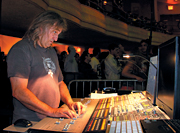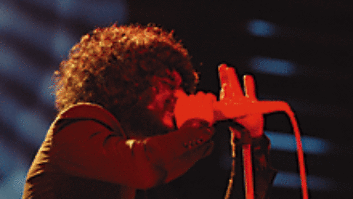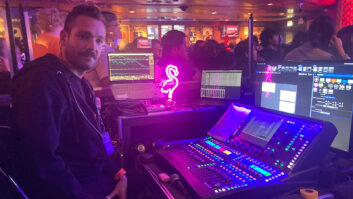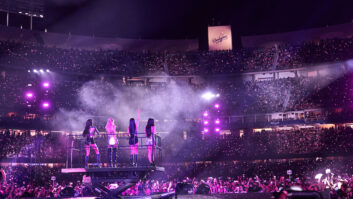
Engineer Toby Francis
Photos: Ralph Heinz
Hardly the “typical” rock act, the Mars Volta weave rock, jazz and Latin music into a highly spontaneous live show. Working with the Mars Volta is like “mixing the first song all night,” says front-of-house ace Toby Francis (pictured), whose clients include ZZ Top, Guns N’ Roses, Smashing Pumpkins, Jane’s Addiction, Limp Bizkit and Velvet Revolver, to name a few. “A good deal of it is improvised, so it’s like two-and-a-half hours of being ready — every night.”
Digidesign’s Profile was the “perfect console for this band. You can get around on it really fast,” says Francis, ever-mindful of the band’s constantly changing show, which also keeps him busy with a Pro Tools HD system for recording all the dates. But the rig offers other advantages: “With Pro Tools, we can be prepared to mix a band before you even get to rehearsals,” Francis explains. “With the Mars Volta, I only had a couple days before going out. I set up in the corridor, tracked the band the first day and worked on the mixes for a couple hours the next morning before they came in. We went out the next day, and those two hours I had before that rehearsal saved me.”
A big part of achieving the right sound for the Mars Volta live comes from plug-ins. “I couldn’t do it without them,” says Francis, who among his faves lists Crane Song’s Phoenix. “It’s absolutely essential. I use it across the mix bus, the drums and percussion, and a couple of the keyboards. I also like Drawmer’s TourBus gates. I use Serato as a dynamic EQ. I have AmpFarm and Eleven on quite a few channels. We’ve eliminated amps on all the keyboards. We create the amps in the console, and it sounds like an isolated amp instead of another open mic onstage.”

The Mars Volta performing
The Mars Volta has a long-standing relationship with Rat Sound, which supplied Renkus-Heinz’ new VLX3 line array — compact dual-12 cabinets with co-entrant MF/HF horn technology, which were successfully used at this summer’s Sturgis Buffalo Chip Music Festival (featuring ZZ Top and Alice Cooper). The Mars Volta took the VLX3s out on the units’ first public tour.
“I really like the sound of the box and the array,” says Francis of the 20-cabinet VLX3 rig powered by Lab.gruppen PLM 10000Q amps with onboard Dolby Lake processing. “I was surprised by how little I had to do — EQ-wise — to make the VLX3s sound the way I wanted. I would describe the sound as a V-DOSC-type, where the low-mids are really clear. It’s amazingly realistic. The Renkus box is a little less bright than V-DOSC, but it’s natural-sounding and gets as loud as any P.A. out there. There’s an amazing amount of low end coming out of the VLX3s. I’m getting a lot of punchy kick drum from the main hangs and hardly using the subs at all.”
VLX3 offers other pluses: “It’s effortless to fly. Everything’s up, in place and cabled in under a half-hour, which is as fast as I’ve ever seen a P.A. go up. And it’s small, especially important in terms of truck space. This is a one-truck tour. We’re carrying full P.A., and in the space left over we’re carrying some of the backline and a moving light package.
“I love this band. It was hard at first, but it’s really helped my chops,” Francis explains. “This whole digital mixing thing has really allowed all of us to rethink how we do things and reset our goals for what we want to achieve.”






